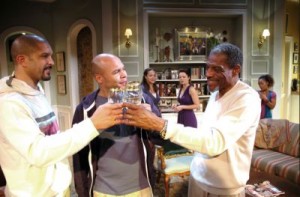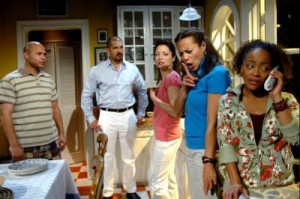
The wealthy LeVay family are having a weekend get-together at their Martha’s Vineyard home away from (Manhattan) home. Housekeeper’s daughter Cheryl is removing slipcovers just in time for younger son Kent to arrive with fiancée Taylor, who is awestruck at the home’s opulence. “I was going to marry you for love,” Taylor tells her handsome beau with a smile, “but now I’m going to marry you for money.” Next to arrive is older son Flip, a successful plastic surgeon, soon to be joined by Kimber, his latest girlfriend. Last to show up is patriarch Dr. Joseph LeVay, who greets Taylor with old world manners—a slight bow and a kiss on the hand. Absent from the weekend gathering are Mrs. LeVay and Cheryl’s mother, for reasons that will eventually become clear. Over the next day or two, family secrets will be revealed and no one will prove to be quite the person he or she has seemed on first impression.
Welcome to the world of Stick Fly, Lydia R. Diamond’s gripping family drama now getting its West Coast premiere in an absolutely splendid production at the Matrix.
If this sounds like a weekend with the Kennedys or the Rockefellers, you’re not far off the mark. It could be any of the moneyed families with estates “on the Vineyard”—with one exception. The LeVays are African American, descendents of the first blacks to own land anywhere on Martha’s Vineyard.
Kent, whom Taylor has nicknamed Spoon, is the family’s black sheep, having chosen to become a soon-to-be-published writer rather than seek a more lucrative profession in medicine or law. He tells Taylor, “They’ll think you’re too good for me,” though upon learning that his older brother’s gal pal is “a little melanin-challenged,” aka Caucasian, Kent begins to think that for this weekend at least, the usual family dynamics may be reversed. He just has to stay the man he’s become when away from the family home. Unfortunately, Dad is once again telling Kent to “take responsibility” for his life and “get a job,” prompting a concerned Taylor to caution her fiancé, “You’re shrinking. Please don’t let him turn you into a 13-year-old.”
Both of today’s female visitors find themselves fish out of water in the LeVay home, Kimber because of her race and Taylor because she grew up lower-middle class, the daughter of a divorced mother whose ex-husband barely acknowledged the child of his first marriage.
Friction, family and otherwise, is everywhere in the LeVay home, between father and wayward son, between “good” brother and “bad” brother, between Taylor and Cheryl (“Why is she being such a bitch?” Taylor wonders), between Kimber and Taylor… and if things start off a bit shaky, just wait till the onion skins start getting removed and those pesky secrets begin to be revealed.
Is Dr. LeVay really the honorable patriarch he seems to be? Is Flip the upstanding son, Taylor the well-adjusted scientist, Kent the n’er-do-well, Kimber the snooty rich girl, Cheryl the “together” high school student? Playwright Diamond has many a trick up her sleeve, and lest you think that Stick Fly is all about drama, be prepared to laugh as well. Diamond’s writing is frequently as funny as it is dramatic.
Stick Fly had its East Coast premiere a year and a half ago at Princeton, N.J.’s McCarter Theatre in a production directed by Shirley Jo Finney and featuring John Wesley as Dr. LeVay and Michole Briana White as Taylor. All three are reunited at the Matrix, joined by Chris Butler (Kent), Avery Clyde (Kimber), Tinashe Kajese (Cheryl), and Terrell Tilford (Flip), and an absolutely glorious design team, making this a production rivaling the best Broadway has to offer.
Under Finney’s assured direction, there’s not a false note in the multilayered performances of every one of the terrific cast. Ovation-winner Butler reveals all of Kent’s doubts and insecurities all the while showing us his backbone and heart of gold. Tilford’s leading man persona makes him the perfect choice for Flip, and his first-rate acting chops reveal the character’s ugly side without ever going over the top. The lovely and talented Clyde takes Kimber from seemingly superficial rich girl to someone quite unexpectedly sharp, warm and empathetic. Though not quite passing for eighteen, Kajese is a petite dynamo as Cheryl, whose reaction to the revelation of one particular secret is powerful and devastating.
Wesley and White’s “history” with their characters shows in the impeccable performances they give. Wesley shows us all of Dr. LeVay’s complexities, from his warmth to his self-righteousness to his innate dignity to the icy coldness he can suddenly reveal. With probably the best of the six roles Diamond has created, White acts the hell out of Taylor. Her unexpected and ultimately hilarious rant against Kimber and the pain she exposes when recalling the father who barely even acknowledged her existence are just two of White’s many breathtaking moments in the role.
John Iacovelli’s superbly detailed set is one of the most gorgeous you’re likely to see in a 99-seat theater. Taking full advantage of the Matrix’s wide, wide stage, Iacovelli has created a living room-kitchen set that looks posh and real enough to make anyone want to move right in, from its elegantly painted walls, to the myriad family photos, bound volumes, and other assorted knickknacks on the shelves. (Kudos to propmaster Chuck Olsen.) There’s even a very real looking hedge revealed behind the front door.
Iacovelli’s set is matched by Christian Epps’ multifaceted yet subtle lighting design. Pay attention to one particularly brilliant example of what a lighting designer can do: morning light streams through the kitchen windows, a softer lighting illuminates the living room, and a bright sun shines down on the outside porch—all at once.
Mitch Greenhil’s sound design is simply marvelous, with the many “sounds of the Vineyard”—seagulls, ocean waves, a fog horn in the distance, rain and thunder, and an eclectic and entirely appropriate choice of music, from R&B to new age.
Epps, Greenhill, and Finney combine forces in several beautifully achieved, fluid scene changes.
Dana Woods’ costumes are just what these characters would wear, and nicely coordinated with the set’s color schemes.
Stick Fly runs over two and a half hours, but it’s so good, so compelling, so involving that time passes by lickety-split. This is not only a play I didn’t want to see end, it’s one I’m hoping to see again. It’s a winner all around.
Matrix Theatre, 7657 Melrose, Los Angeles.
www.plays411.com/stickfly
–Steven Stanley
April 10, 2009
Photos: I.C. Rapoport




 Since 2007, Steven Stanley's StageSceneLA.com has spotlighted the best in Southern California theater via reviews, interviews, and its annual StageSceneLA Scenies.
Since 2007, Steven Stanley's StageSceneLA.com has spotlighted the best in Southern California theater via reviews, interviews, and its annual StageSceneLA Scenies.







 COPYRIGHT 2024 STEVEN STANLEY :: DESIGN BY
COPYRIGHT 2024 STEVEN STANLEY :: DESIGN BY